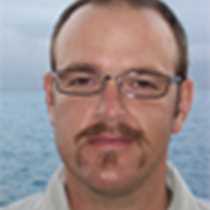Plaza and Santa Fe Islands
As the sun poked through the clouds with its sporadic beams, we all noticed that there was a different movement present on the surface as we anchored at Urbina Bay. This shallow bay had over two square kilometers uplifted out of the ocean in 1954 and in certain areas up to five meters were thrust into the equatorial sun. We were surrounded by high shield volcanoes from Isabela and Fernandina Islands as we made our way to a steep beach to land and start our hike. As we started out on the trails we noticed remnants of this uplift as we found bleached mollusks, tube worms, and coral heads inland. The vegetation was equally interesting, as all of the species arrived and flourished after 1954 with many salt resistant representatives present. Male Galapagos Land iguanas appeared to be sticking out of the ground as they relaxed in their burrows, awaiting a possible mate to pass by. As we cut farther inland we were pleased to find Galapagos tortoises from the Alcedo volcano population. This particular sub-species makes a long migration from the highlands to the coastal lowlands through the two seasons that occur here. Young tortoises were encountered as they wandered in this coastal zone where they will remain for years before they recognize the path that leads them to the highlands eventually. Darwin ground finches flitted back and forth as they fed along the path awaiting the first rains to arrive. Production of a renewed food source with the flowering plants and insects will arrive with the moisture. Upon our return to our landing beach we took a quick swim to cool us off so we could continue our navigation north along the coast of this massive island.
We arrived to Tagus Cove in the afternoon and immediately noticed the writings on the steep cliff walls of these eroded cones. This tradition of claiming territory dates back to the early 19th century with the first scribbles carved in 1836. Charles Darwin visited this site in 1835 and was disappointed at the lack of fresh water in the inland ponds. Hyper-saline lakes were produced from dropping sea levels and evaporation of the contents. We eventually climbed to a viewpoint where we were able see the majestic shield volcanos of Isabela Island. Endemic Scalesia bushes showed us that isolation has produced uniqueness. Kayakers, snorkelers, and Zodiac riders all explored the coastal area finding an interesting mix of Galapagos Penguins, Brown pelicans, Flightless Cormorants, Sea lions, and mating Pacific Green sea turtles. Late in the afternoon the sun dipped behind Fernandina Island in the distance while returning a few sun beams to us and the surface of the calm Pacific Ocean.







